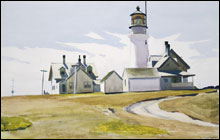 Word has it that famed, Boston-born (in 1836) artist Winslow Homer learned to paint from his mother, a skilled amateur watercolorist of flowers who recognized her son’s talent for drawing from the time he could hold a pencil. It wasn’t until he was 37 years old, however, in 1873, after years of working as an illustrator and later painting in oils in New York and Paris, that Homer began to paint in watercolors himself, inspired by a summer trip to Gloucester. He continued to explore this medium during summer trips to New England throughout the 1870s and in the process began pushing the medium beyond its traditional limits, scratching into the surface of his paper to create highlights, for example, and experimenting with opaque applications of paint called washes. Until this time, works on paper usually served as studies for oil paintings, and Homer’s practice of painting complete scenes in watercolor and exhibiting them as finished works in galleries put him in the forefront of what was in the mid 1870s a brand new trend.
Word has it that famed, Boston-born (in 1836) artist Winslow Homer learned to paint from his mother, a skilled amateur watercolorist of flowers who recognized her son’s talent for drawing from the time he could hold a pencil. It wasn’t until he was 37 years old, however, in 1873, after years of working as an illustrator and later painting in oils in New York and Paris, that Homer began to paint in watercolors himself, inspired by a summer trip to Gloucester. He continued to explore this medium during summer trips to New England throughout the 1870s and in the process began pushing the medium beyond its traditional limits, scratching into the surface of his paper to create highlights, for example, and experimenting with opaque applications of paint called washes. Until this time, works on paper usually served as studies for oil paintings, and Homer’s practice of painting complete scenes in watercolor and exhibiting them as finished works in galleries put him in the forefront of what was in the mid 1870s a brand new trend.
“American Watercolors and Pastels, 1875–1950,” which opens at the Fogg Art Museum on April 8, explores the dramatic shift in the status of watercolor during this period, presenting more than 50 examples drawn primarily from the Fogg’s own collection. Artists have taken the medium in a great variety of directions, and this exhibition reflects that diversity, with works by enthusiast and virtuoso John Singer Sargent, Massachusetts-lighthouse appreciator Edward Hopper, and experimental modernist artists John Marin, Charles Demuth, Georgia O’Keeffe and Arthur Dove, among many others.

Another delicate medium — the toothpick — forms the underpinning for sculptures inspired by nature’s patterned and filigreed structures in “Beth Galston: Fragilities,” which opens at Boston Sculptors Gallery on April 19. Galston’s cascading and intersecting works are being shown on a double bill with “Ann Torke: Road Residue,” in which Tork continues her ongoing project of making significant driving trips with sheets of acetate attached to her car, capturing the actual residue from each journey to exhibit as lightbox installations that act almost like film frames, real and also metaphorical records of her travels.
The complex blending of cultures, ethnicities, histories, and genders — and the array of words, symbols, gestures, and sounds used to articulate them — inspires “Mixing Speak,” which opens at the New Art Center on April 17, curated by exhibitions director Ceci Mendez. Nine artists draw on sources as disparate as Afro-Cuban/Brazilian/Taino religion, 19th-century photographs of “American Indians,” and the Mexican Lotería (a form of bingo) to give visible, and audible, expression to complex issues of identity and society as we are experiencing them.
“American Watercolors and Pastels, 1875-1950” | April 8-June 25 | Harvard’s Fogg Art Museum, 32 Quincy Street, Cambridge | 617.495.9400 | “Beth Galston: Fragilities” and “Ann Torke: Road Residue” | April 19-May 20 | Boston Sculptors Gallery, 486 Harrison Avenue, Boston | 617.482.7781 | “Mixing Speak” | April 17-May 21 | New Art Center, 61 Washington Park, Newtonville | 617.964.3424
On the Web
Fogg Art Museum: www.artmuseums.harvard.edu
Boston Sculptors Gallery: www.bostonsculptors.com
New Art Center: www.newartcenter.org